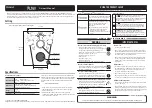
Remote control commands
R&S
®
NRPM
140
Mannual 1425.8663.02 ─ 08
p
t
A
B
C
A
D
E
F
D
1
1
1
2
3
Figure 10-1: Significance of the drop-out time parameter
1 = Dropout time
2 = Trigger hysteresis
3 = Trigger level
The RF power between the slots is below the threshold defined by the trigger
level and the trigger hysteresis. Therefore, the trigger hysteresis alone cannot
prevent triggering at B or at C. Therefore, set the dropout time greater than the
time elapsed between points D and B and between E and C, but smaller than the
time elapsed between F and A. Therefore, ensure that triggering takes place at A.
Because the mechanism associated with the dropout time is reactivated when-
ever the trigger threshold is crossed, you can obtain also unambiguous triggering
for many complex signals.
If you use a hold-off time instead of a dropout time, you can obtain stable trigger-
ing conditions - regular triggering at the same point. But you cannot achieve
exclusive triggering at A.
Hold-off time
During the hold-off time, a period after a trigger event, all trigger events are
ignored.
Controlling the measurement
















































